
NPS / Jacob Frank
Reptiles are a very broad class of vertebrates that breathe air and have scales covering all or part of their bodies. While Dinosaur National Monument is known mostly for its extinct reptiles, there are at least 14 confirmed species of extant (living) reptiles still residing in the monument today. The park is home to 6 species of lizards and 8 species of snakes, 3 of which are venomous. Although testudines (turtles, tortoises, and terrapins) also lived here millions of years ago, today only their fossils remain. A note on scientific names: Taxonomy is the system scientists use to classify all living organisms. Under this system, every organism has at least two names (a genus name and species name) that makes up their "scientific name." Sometimes, these names change as scientists learn more about a particular organism. Recently, several of our reptiles' scientific names have changed. While the NPS Species tool may use older names, the names listed on this webpage are correct as of February 2022. For a complete list of reptiles found in Dinosaur National Monument, use the NPS Species tool below. Select a Park:Select a Species Category (optional):
Search results will be displayed here.
LizardsCommon Sagebrush Lizard (Sceloporus graciosus)Plateau Fence Lizard (Sceloporus tristichus) Ornate Tree Lizard (Urosaurus ornatus) Side-blotched Lizard (Uta stansburiana) Greater Short Horned Lizard (Phrynosoma hernandesi) Western Whiptail (Aspidoscelis tigris) 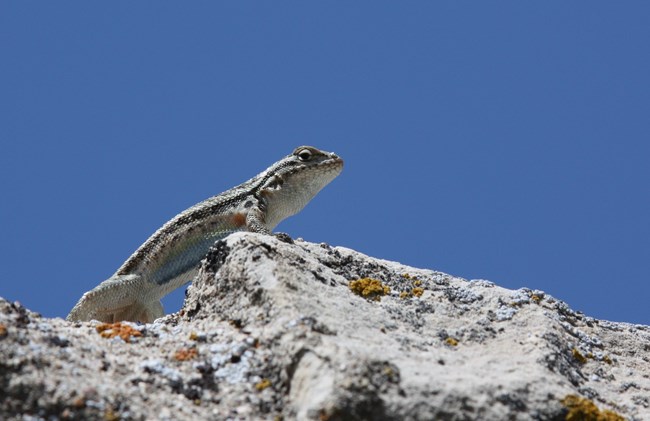
NPS / Dinosaur National Monument Common Sagebrush Lizard (Sceloporus graciosus)The common sagebrush lizard is similar in both appearance and range to the plateau fence lizard, which also resides in Dinosaur National Monument. Scientists tell the difference between these lizards by looking at the number of scales between their lower legs. However, in our area, sagebrush lizards tend to have a dark "bar" or dot on their shoulders. Some also have rusty coloring near their armpits. Most adults are between 4 and 6 inches (10 to 15 cm) in total length. True to its name, the sagebrush lizard is a year-round resident of the sagebrush ecosystem. They are gregarious with other lizards, but are often fearful of humans.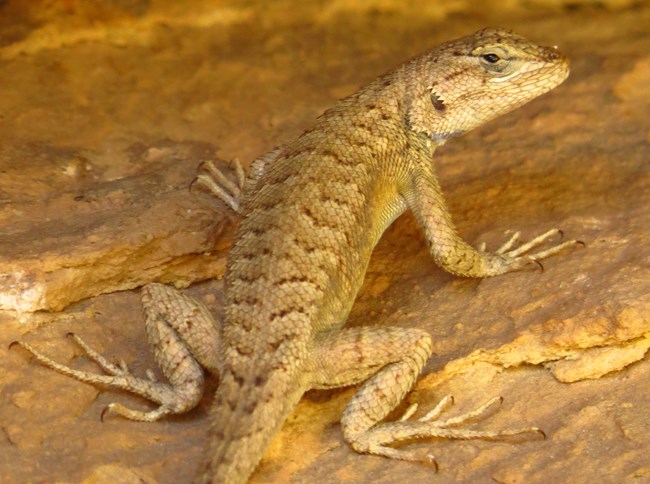
NPS / Cindy McIntyre Plateau Fence Lizard (Sceloporus tristichus)Plateau fence lizards are very similar to common sagebrush lizards in both appearance and range. This is due in part to the fact that both lizards belong to the same genus, Sceloporus. Although they are different species, they are believed to be closely related. Lizards of the Sceloporus genus have "keeled" scales, where the center of each scale rises to a point, like the keel of a ship. Like sagebrush lizards, plateau fence lizards don't get much bigger than about 6 inches (15 cm) in total length. However, plateau fence lizards don't typically have the dark "bar" or spot on their shoulder that's common in sagebrush lizards of this area.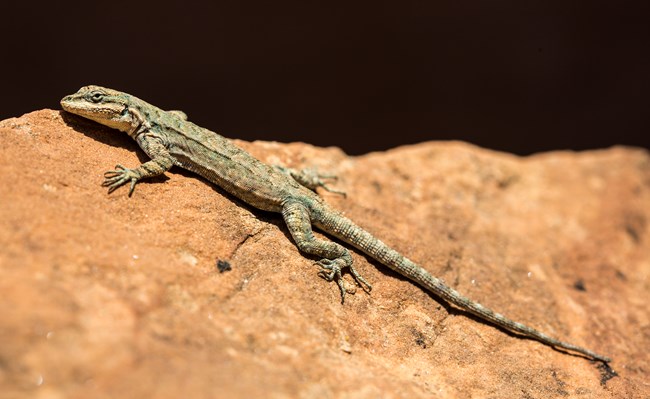
NPS / Jake Frank Ornate Tree Lizard (Urosaurus ornatus)Although they don't typically grow bigger than about 2.5 inches (6.3 cm), ornate tree lizards are still a treat to look at! They can come in a variety of colors, including black, brown, gray, tan, or pale yellow. They often have brightly colored throats and unique patterns on their backs. Adult males also have blue or green patches on their bellies. Regardless of color though, ornate tree lizards have granular scales on the body with larger scales running down the spine. As the name suggests, they prefer habitats with trees. Look for them in the cottonwoods of riparian zones, or even pinyon pines and junipers in drier areas.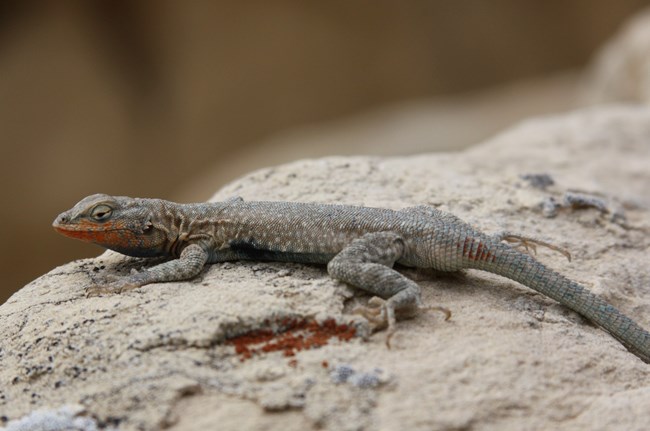
NPS / Dinosaur National Monument Side-blotched Lizard (Uta stansburiana)Side-blotched lizards are common throughout the West, especially in semi-arid regions with pinyon-juniper pine woodlands, like Dinosaur National Monument. They are both recognized by and named for the inky blotch of bluish coloring near their armpits. However, side-blotched lizards can sport a variety of patterns and colors on the rest of their bodies. Their backs can be light tan or gray. Males often have brighter colors than females, and sometimes sport bluish speckling. During the breeding season, the males' throats may be orange, yellow, or blue. They typically grow up to about 5 inches (12.7 cm) long.
NPS / Conrad Provan Greater Short Horned Lizard (Phrynosoma hernandesi)Often called "horntoads," these spiky reptiles blend in easily with their pinyon-juniper woodland habitats. They have a broad, flattened body shape, and grow up to about 6 inches (15 cm) in total length. Despite their size, horned lizards have a variety of adaptations to help them fend off predators. The most noticable is their sharp spikes, which cover the head, back, sides, arms, legs, and tail. When threatened, these lizards puff themselves up to appear bigger and spikier than they actually are. If all else fails, horned lizards have the unnerving ability to squirt blood from their eyes up to 3 feet (1 m) away! The blood contains a chemical that bad-tasting and noxious to canines.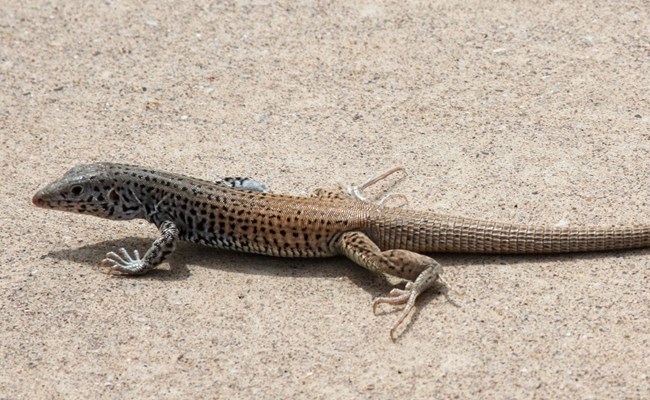
NPS / Dinosaur National Monument Western Whiptail (Aspidoscelis tigris)Whiptail lizards are a common sight at Dinosaur, especially in sagebrush habitats. They have narrow heads, slender bodies, and max out at about 12 inches (30.5 cm) in length. They're usually spotted. The front half of the body is tan or gray, while the back end is reddish-brown or orange in color. Babies are more brightly colored, with blue tails. Western whiptails used to be grouped in the genus, Cnemidophorus, but scientists now believe they are more closely related to members of the Aspidoscelis genus. While some species in the Aspidoscelis genus have only female members that reproduce asexually (like the New Mexican whiptail, A. neomexicana), western whiptails can be male or female.Non-Lethal SnakesNorth American Racer (Coluber constrictor)Great Plains Ratsnake (Pantherophis emoryi) Milksnake (Lampropeltis gentilis) Striped Whipsnake (Coluber taeniatus) Gopher Snake (Pituophis catenifer) Western Terrestrial Garter Snake (Thamnophis elegans) 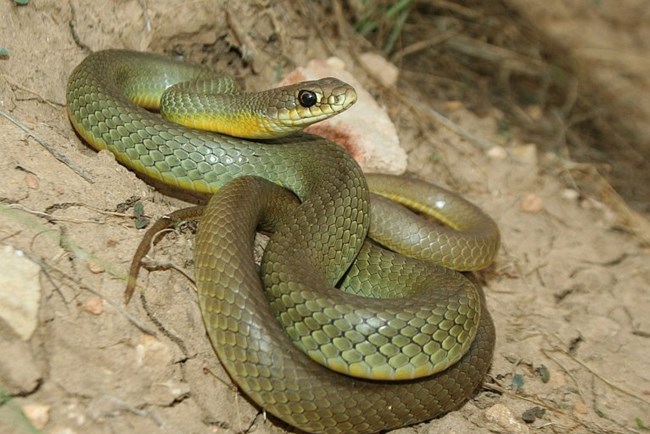
NPS / Channel Islands National Park North American Racer (Coluber constrictor)NonvenomousBecause of its wide range, this snake goes by many names. Often, the names will describe the snakes' color (black, blue, yellow-bellied, etc.) or a region they can be found in. However, racers are one of the most widespread snakes in North America, especially in the United States. They can also come in a variety of colors. Unsurprisingly, there are many subspecies of racer localized to specific regions. The subspecies in this area is the western yellow-bellied racer (Coluber constrictor mormon). Adults are typically yellowish or olive green, and may grow up to 6 feet (2 m) in length. As the name suggests, they can move very quickly, but they're elusive. 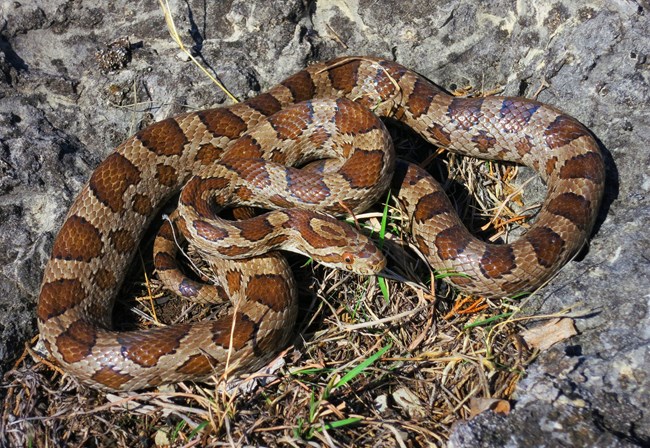
Peter Papalanus, Flickr, CC BY 2.0 License, no changes made Great Plains Ratsnake (Pantherophis emoryi)NonvenomousThis constrictor is small, only reaching up to about 36 inches (91 cm) in length. They are usually light brown or gray, with brown blotches on their bodies, often ringed in a darker color. They are characterized by a brown eye stripe and a pattern on the top of the head that may resemble a spear tip. Like other ratsnakes, the Great Plains ratsnake may vibrate its tail if it feels threatened. While the tail itself is silent, it can resemble the sound of a rattlesnake if the tail hits leaf litter or debris. This snake prefers grasslands or lightly forested areas, where it helps control rodent populations. Its scientific name has changed several times, but was reclassified from the genus Elaphe to Pantherophis in the 2000s. 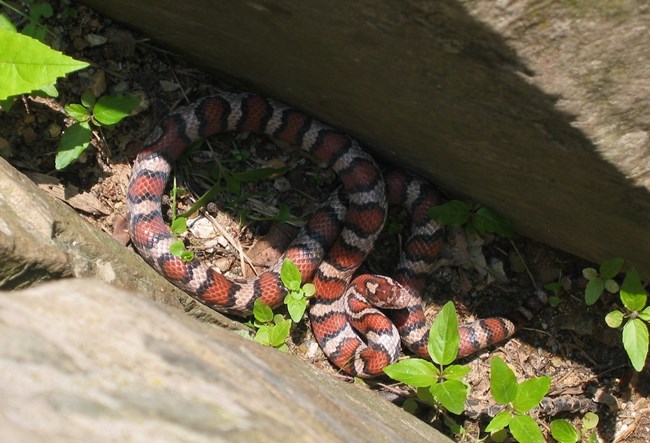
NPS / Great Falls Park Milksnake (Lampropeltis gentilis)NonvenomousThis is a wide-ranging snake, common across the United States. Because of this, there are many subspecies of milksnake. The one found here is the Utah milksnake (Lampropeltis gentilis taylori). Milksnakes in this area can be similar in appearance to the Great Plains ratsnake, but they typically have more vibrant coloring. The body is pale, gray, or light brown, with darker bands of red, orange, or brown bordered in black. While ratsnakes tend to have a more discernable head with a skinny neck, milksnakes generally have short, thick necks about the same width as the head. Adults are usually between 15 to 33 inches (39 to 85 cm) long. Bizarrely, the name comes from an old folk belief that these snakes could milk cows. 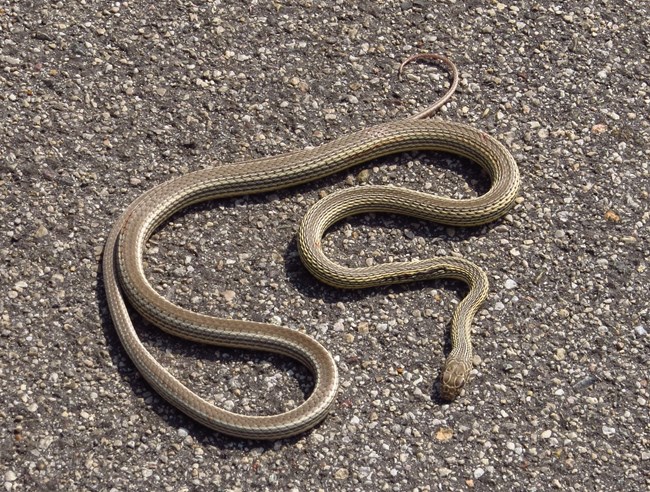
NPS / Cindy McIntyre Striped Whipsnake (Coluber taeniatus)NonvenomousPreferring canyon, sagebrush, and pinyon-juniper woodland habitats, whipsnakes are right at home in Dinosaur National Monument. Named for their whip-like appearance, these snakes are usually tan, brown, or black, with paler stripes running the length of their bodies. The tip of the tail is often pinkish in color. Adults are large, capable of growing up to 5 feet (1.5 m) long. They are also whip-fast and hard to spot because their stripes serve to break up their appearance as they move. Whipsnakes can be aggressive. Even though they aren't venomous, most will not hesitate to bite if they feel threatened. 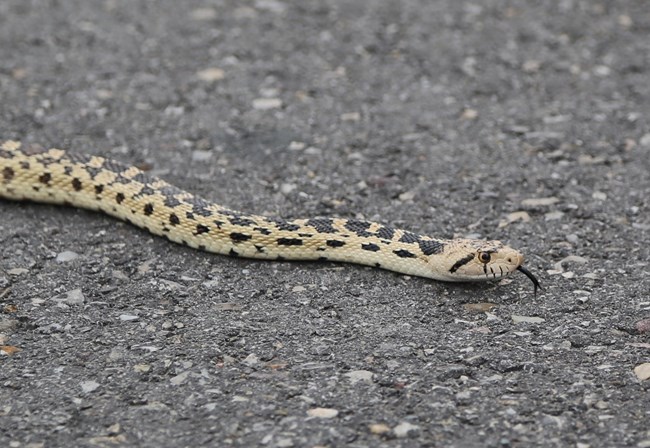
NPS / Dan Johnson Gopher Snake (Pituophis catenifer)NonvenomousGopher snakes are large constrictors, typically between 4 and 8 feet (1.2 to 2.4 m) in length. They are yellow or tan in color, with black or dark brown blotches that are square or "saddle" shaped on the spine. Although gopher snakes are known to eat rattlesnakes, when threatened, they will mimic rattlesnake behavior by coiling into a strike posture, flattening their heads, and shaking their tails (even though they don't have a rattle). They do this in hopes of scaring away their attackers. Another popular name is "bull snake." While the names are often used interchangably, true bull snakes (Pituophis catenifer sayi) are actually a subspecies of gopher snake more common in the central United States. The subspecies in this area is the Great Basin gopher snake (Pituophis catenifer deserticola). 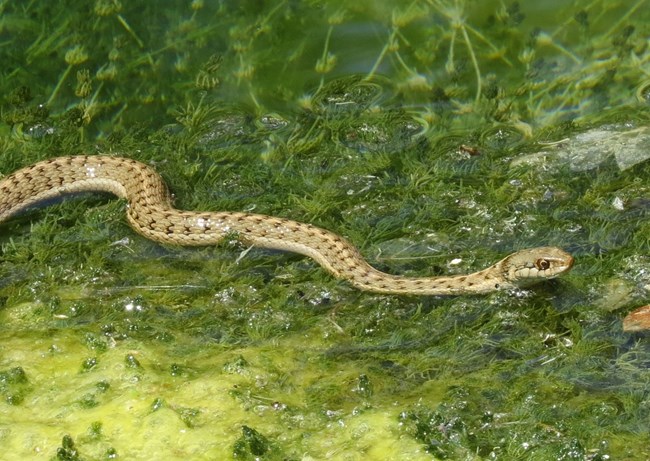
NPS / Dan Johnson Terrestrial Garter Snake (Thamnophis elegans)Weakly venomous, but non-lethalWhile western terrestrial garter snakes do posess a mild venom in their saliva, it's not potent enough to harm humans (or anything much larger than a mouse). They have no fangs either, so bites rarely result in anything more than mild irritation. Like other species of garter snake, western terrestrial garter snakes are beneficial contributors to the ecosystem. They prefer riparian (wetland) habitats, where they hunt rodents, slugs, leeches, amphibian larvae, and small fish. They are usually greenish or tan in color with pale stripes running down the sides and the top of the back. They often have reddish, brown, or black spots between the stripes. They can grow up to 41 inches (104 cm) long. Highly Venomous SnakesThese venomous snakes are native to Dinosaur National Monument. They are important members of the ecosystem, protected by federal law. They won't bite unless they feel threatened, so leave them alone. Don't try to harm or kill them, or you could face charges. If you are bitten, leave the snake alone and call 911 immediately!Midget-faded Rattlesnake (Crotalus oreganus concolor) Prairie Rattlesnake (Crotalus viridis) 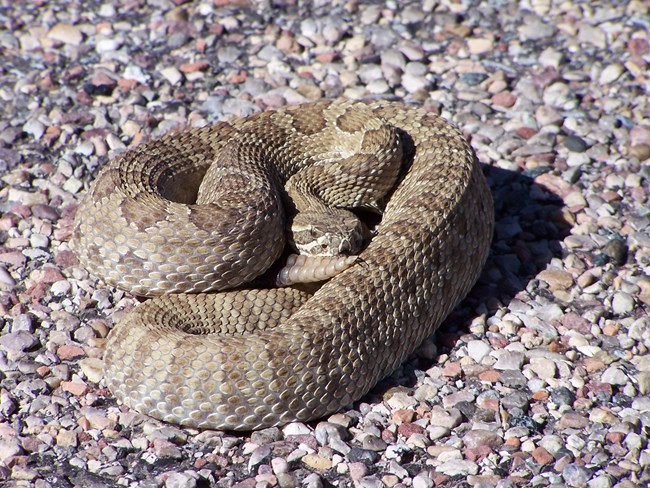
NPS / Dinosaur National Monument Midget-faded Rattlesnake (Crotalus oreganus concolor)VenomousThis is a smaller subspecies of the western rattlesnake. While they can grow up to 2.5 feet (75 cm) long, most adults are only about 1.5 feet (45 cm) in length. Don't let the size fool you, though. This snake possesses one of the most lethal venoms of any snake in the United States. This is due to an element called "concolor toxin," which affects the nervous system. Unlike other rattlers, the midget-faded rattlesnake's venom does not drop in toxicity as the snake reaches adulthood. Fortunately, they're unlikely to bite if left alone. Don't turn over rocks or logs where snakes may be resting. Give them plenty of space. 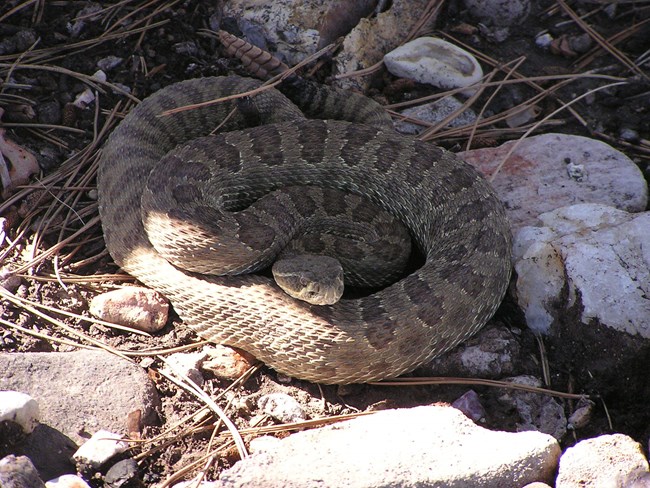
NPS / Wind Cave National Park Prairie Rattlesnake (Crotalus viridis)VenomousWhile prairie rattlesnakes have been confirmed in Dinosaur National Monument, they are rare here. There aren't many distinguishing features between prairie rattlesnakes and midget-faded rattlesnakes other than size. Adult prairie rattlesnakes are capable of reaching 5 feet (1.5 m) in length, while midget-faded rattlesnakes are rarely over 2 feet (60 cm) long. Despite being larger, prairie rattlesnake venom is less potent than that of the midget-faded rattlesnake, though still dangerous. Like most rattlers, prairie rattlesnakes are unlikely to bite as long as they're left alone. Don't turn over rocks or logs where snakes may be resting. Give them plenty of space. What to do if you are bitten by a rattlesnake...Rattlesnakes are the only highly venomous snakes at Dinosaur National Monument. Their venom is both hemotoxic (affecting the blood and tissues) and neurotoxic (affecting the nervous system and brain). While most bites are not fatal, they can cause serious harm or death if left untreated. If you are bitten, do the following:
|
Last updated: July 2, 2025
